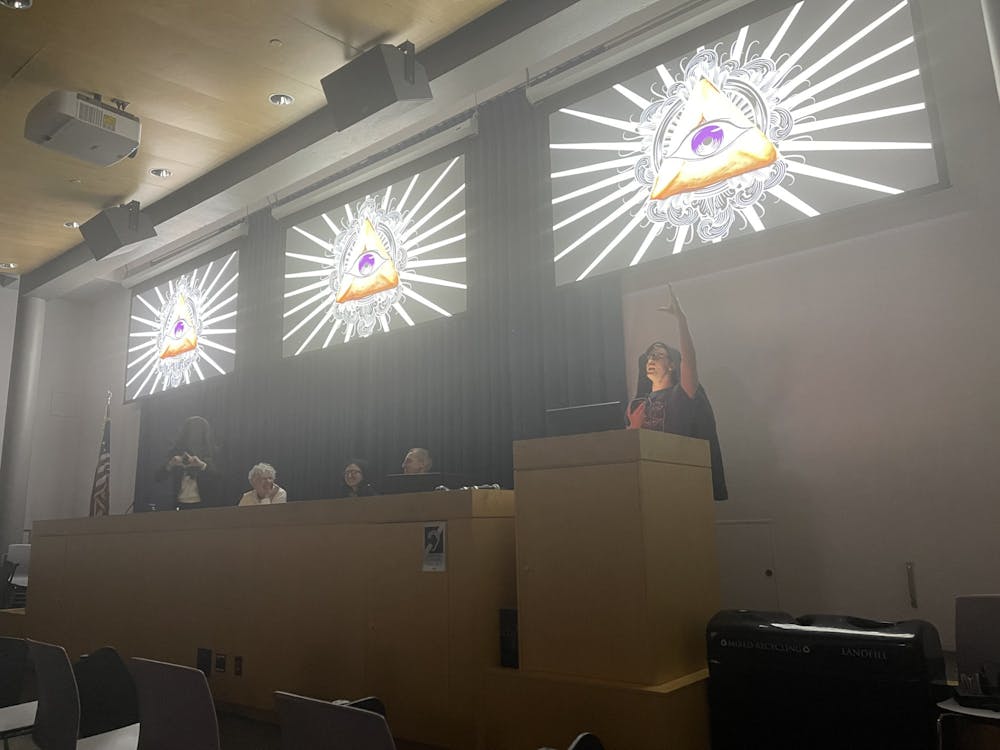On March 15 in the Whig Senate chamber, Princeton students congregated for “the debate of the year” — at least according to advertising ahead of the event by the Center for Jewish Life (CJL), which worked with Whig-Clio and Fuzzy Dice to pull it off.
The event was the annual Latke-Hamantaschen debate, which pits students and faculty against each other to determine which Jewish food reigns supreme, according to Madeleine LeBeau ’24, student vice president for programming at the CJL.
“Tonight we embark on our annual quest to resolve the profound and weighty — well … depending on your recipe — question as to which reigns supreme: the latke or the hamantaschen,” LeBeau said.
LeBeau is a News Contributor for The Daily Princetonian.
The debate was moderated by Dean of the College Jill Dolan, who could hardly be expected to be impartial in arbitrating since she advocated in 2015 on the side of the latke.
“As you can imagine, the stakes are very high,” Dolan told the ‘Prince,’ explaining why she found moderating “much easier.” “As a moderator, I just tried to keep it fair, keep it honest, and keep it good.”
“Something quite remarkable about this debate is that it began at the University of Chicago in 1946 and has taken place on the Chicago stage every year since then,” Dolan said at the debate, “with the Professors dressing in full regalia.”
“I am glad that is not the case for us,” Dolan added to general laughter from the crowd.

Representing the Hamantaschen were Professor of Music Gavin Steingo and Fuzzy Dice’s John Ehling ’24. The Latke team consisted of Lecturer of Near Eastern Studies Philip Zhakevich and Fuzzy Dice’s Molly Lopkin ’25. The Latke team won the opening coin toss and opted to go second in their defense.
Steingo opened the debate with his “Three Theses of the Hamantashen.”
“The first thesis that I present is that the hamantaschen has the superior form conforming to the Golden Ratio,” Steingo said. “The second thesis is that the sound of the word is superior.”
In an effort to corroborate this statement, Steingo presented a “study” that was conducted to see babies’ reaction to the respective words.

“When Dean Dolan whispered the word ‘hamantaschen’ in the ears of 30 6-month-old babies, they smiled so beautifully and their breathing was relaxed. When the word ‘latke’ was said, there was a palpable sense of displeasure,” Steingo said to the audience’s amusement.
His third thesis was that it inspired advancements of music and art, such as with Susannah Perlman’s “Hamentaschen Song.”
The “Latke Team” presented next, and Zhakevich employed a largely etymological approach to defending the latke.
“Hamantaschen contain flour, with the Hebrew word for flour occurring only 14 times across ten books in the Bible,” Zhakevich said. “One of the main ingredients in frying latkes, oil, appears 193 times in 26 books. So clearly, it appears more because they were using it to fry latkes.”
Ehling presented the second hamantaschen defense pointing to its linguistic superiority.
“Iambic pentameter has been used in various famous quotes like ‘To be or not to be, that is the question’ and ‘We hold these truths to be self evident’ and ‘The hamantaschen is better than the latke,” Ehling said.
He then recited a slightly altered version of a soliloquy from The Scottish Play:
“Hamantaschen, hamantaschen creeps in this petty place of hamantaschen to the last syllable of hamantaschen and all our hamantaschen-laden fools the way to hamantaschen. In hamantaschen, the latkes are but a walking shadow, a whore pancake that struts and frets his hour on the plate and then is eaten no more. It is a fool, eaten by an idiot, full of empty calories, signifying nothing,” Ehling recited.
Then, Ehling and Steingo, clad in cloaks under dimmed lights, inducted the audience into the “Cult of the Hamantaschen” by re-enacting the “O Captain, My Captain” scene in Dead Poet’s Society.
Fuzzy Dice’s Lopkin then presented a slam poem and diss track on behalf of the Latke, contradicting Ehling’s assertion that the hamantaschen was better for its conformity to iambic pentameter.
“Your sides are one, two, three, we got the whole diameter/You’re lucky I didn’t say this rap in iambic pentameter,” Lopkin said.
After the debate, the audience was allowed to direct questions to the panelists.
“How does the hamantaschen team respond to their association with genocide,” an audience member asked, referring to the story of the Jewish holiday of Purim.
Ehling responded: “We are very sorry.”
The next question, directed to Lopkin, asked if she came up with the previous rap-rebuttal after hearing the hamantaschen’s presentation on iambic pentameter.
“Sure, let’s go with that,” said Lopkin.
The audience was requested to vote via a QR code, and Dolan read out the result by interpreting an excel graph.
In an Academy Awards-esque blunder, Dolan accidentally announced that Hamantaschen had won the debate before correcting her mistake, announcing instead the Latkes as the true victor.
“I have trouble reading graphs at times,” Dolan said.
In an interview with the ‘Prince’ asking why they chose to defend their respective delicacies, Steingo, Zhakevich, and Lopkin each responded: “Because we were assigned.”
Aidan Iacobucci is a Staff News Writer for the ‘Prince.’ He can be reached at iacobucci@princeton.edu or @aidaniaco on Instagram.








